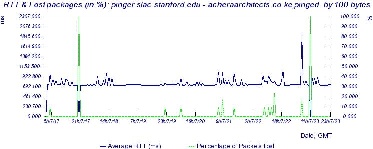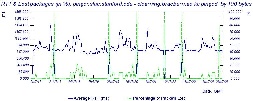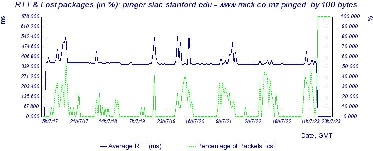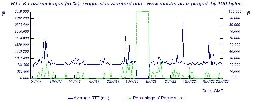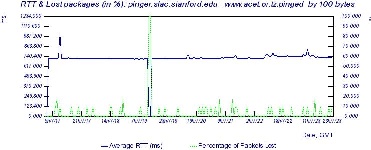Introduction
The Seacom undersea fibre optic cable plugging East Africa into high speed Internet went live Thursday July 23, 2009. See the BBC and CNN reports. This should enable the improved performance (increased bandwidth, reduced Round trip Times (RTT), and less congestion and thus jitter.
Initial Results
One would expect with the use of a terrestial fibre rather than a geo-stationary satellite that the minimum RTT woud be reduced from >=40ms to 200-300ms as seen from the US. Also the reduced congestion enabled by the higher speed links should make the average RTT more stable and reduce the packet loss. Below are shown the average RTTs and losses from SLAC on the West Coast of the US to various hosts on the East Coast of Africa.
|
acheraarchitects.co.ke |
loans.co.ke |
elearning.braeburn.ac.ke |
|---|---|---|---|
Kenya |
|
|
|
|
www.micti.co.mz |
www.uem.mz |
|
Mozambique |
|
|
|
|
www.muchs.ac.tc |
www.6telecoms.co.tz |
www.acet.or.tz |
Tanzania |
|
|
|
It is apparent we do not observe any dramatic reduction in RTT on July 23rd. We also looked at the PingER recorded RTT from ICTP Trieste, Italy to a host in Tanzania in case the routes from SLAC were still using satellite while those from Italy were not. We also looked at the RTT seen from a TENET host in cape Town South Africa to a host in Mozambique. In this case (see below) the RTTs have long been << 400ms so they already were not using geostationary satellite to connect the sites.
www.muchs.ac.tz From Trieste |
www.micti.co.mz from Cape Town |
|---|---|
|
|
Again there is no dramatic reduction.
According to the BBC report five institutions are already benefiting from the faster speeds - national electricity company Tanesco, communications company, TTCL, Tanzania Railways and the Universities of Dar es Salaam and Dodoma. we also heard from Alem who was visiting Kenyata University from Ethiopia for a one day conference that "You can get connected and download data like what you can do in Europe."
From SLAC, we pinged hosts at each of these organizations, the Round Trip Time (RTT) results in msec. are shown below: For the # pings with an asterisk the host did not respond to pings so we used synack to probe the web server:
Country |
Organization |
Host |
# pings |
Min RTT |
Avg RTT |
Max RTT |
Std dev |
Loss |
|---|---|---|---|---|---|---|---|---|
Tanzania |
Tanzania railways |
www.trctz.com |
100 |
764 |
790 |
893 |
19.5 |
0% |
Tanzania |
Tanzania Telecommunications Company |
www.ttcl.co.tz |
100* |
714 |
721 |
730 |
4.3 |
1% |
Tanzania |
University of Dar Es Salaam |
www.udsm.ac.tz |
151 |
696 |
711 |
1130 |
45 |
0% |
Tanzania |
University of Dodoma |
www.udom.ac.tz |
100* |
753 |
783 |
845 |
18 |
0% |
Tanzania |
Tanesco National Electric Company |
www.tanesco.com |
49 |
12.6 |
12.997 |
13.53 |
0.251 |
0% |
Kenya |
Kenyatta University |
www.ku.ac.ke |
138 |
650.138 |
652.36 |
668.44 |
1.97 |
2% |
The host www.tanesco.com is probably a proxy located somewhere in the Western US. The other hosts all have minimum RTTs of well over 400ms which indicates they are probably still using a geo-stationary satellite.
When looking at the lack of effects seen initially following the fibre install it is important to understand the caveats.
Adding Extra Hosts
We received suggestions from Don Riley of UMD:
I would be watching kdn.co.ke, kenet.or.ke in Kenya. maybe also Univ. of Nairobi.
KDN should change soon, since they're connecting directly to SEACOM and lighting fiber to Uganda and Rwanda. KENET should be first on the university side, I think. and Univ. of Nairobi - typical for lead univ. in capitol to come up first. Similar in TZ and MZ, but looks like you've got the right lead univ's there. Would probably track MORENET and TERNET there.
We have been monitoring kdn.co.ke so we will have a nice history and see the change.
Kenet.or.ke does not respond to pings, response time to its web server (kenet.or.ke:80) has a response time of about 667ms.
For the University of Nairobi I Googled it and got www.uonbi.ac.ke however it has an RTT of 78ms from SLAC and appears to be in Virginia USA. Instead I added library.uonbi.ac.ke that is a University of Nairobi host that appears to be in Nairobi. ON 7/25/09 it had an RTT of ~ 658ms.
I googled MORENET Mozambique and came up with morenet.mct.gov.mz. However it does not respond to pings. It does respond to port 80 (www) and the response time to a trivial request is ~368ms so it may have already moved over. However GeoIPTool (see http://www.geoiptool.com/en/?IP=morenet.mct.gov.mz) says it's in Buenos Aires which I do not believe. Visualroute's (at http://visualroute.visualware.com/) tests fail. Looking at the traceroute from SLAC and using GeoIPTool to locate the nodes , it appears that on leaving the US it goes directly deom the West Coast of the US (Sunnyvale) through Buenos Aires (node telkomsa.ge9-16.br02.ldn01.pccwbtn.net 152ms) then to Pretoria (rrba-ip-lir-1-pos-1-0-4.telkom-ipnet.co.za 352 ms) and then to Mozambique. This it is not currently using the new fibreoptic cable running South down the E. African coast. Looking at a map of the world's undersea fibre cables in the region may help explain this.
I have added www.ternet.or.tz on 7/25/09 it had a ping RTT of 705ms.
